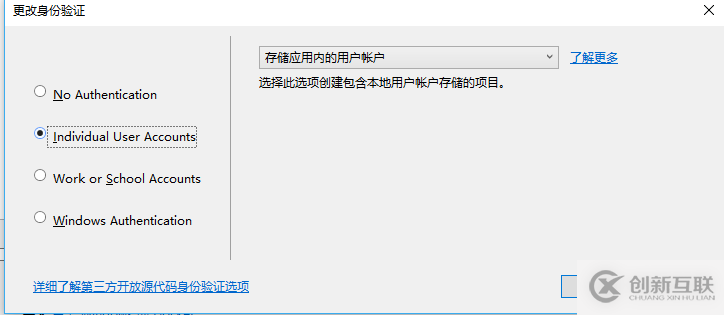CodeFirst如何搭建Asp.NetCore2.0網(wǎng)站-創(chuàng)新互聯(lián)
這篇文章主要介紹CodeFirst如何搭建Asp.Net Core2.0網(wǎng)站,文中介紹的非常詳細(xì),具有一定的參考價(jià)值,感興趣的小伙伴們一定要看完!

一步步教大家如何搭建Asp.Net Core2.0網(wǎng)站,以下所有都是建立在.NETCore2.0環(huán)境已經(jīng)搭建好
右鍵解決方案>新建項(xiàng)目>
選擇Web>ASP.NETCoreWeb應(yīng)用程序(.NET Core)

選擇Web應(yīng)用程序,暫時(shí)不選擇啟用Docker,身份驗(yàn)證選擇個人用戶賬戶(會自動生成一系列和用戶認(rèn)證的代碼)


隨后生代碼層次目錄如下:

其中會包含身份信息的相關(guān)實(shí)現(xiàn),比如相關(guān)實(shí)體信息(user)之類的,如果想對擴(kuò)展微軟自動的生成的用戶實(shí)體類,可在Models中的ApplicationUser下擴(kuò)展,在此ApplicationUser中添加屬性即可:比如添加叫WeChatId屬性,添加后如下:
using System;
using System.Collections.Generic;
using System.Linq;
using System.Threading.Tasks;
using Microsoft.AspNetCore.Identity;
namespace DotNetCore20.Web.Models
{
// Add profile data for application users by adding properties to the ApplicationUser class
public class ApplicationUser : IdentityUser
{
/// <summary>
/// 微信Id
/// </summary>
public string WeChatId { get; set; }
}
}在之后生成運(yùn)行并遷移,數(shù)據(jù)庫的AspNetUsers中就會多出WeChatId 屬性.
一:安裝引用
nugnet恢復(fù)引用失效時(shí),可在程序包管理控制臺輸入:
dotnet restore 即可

會發(fā)現(xiàn)在恢復(fù)指令后在NuGet中會有一個Microsoft.VisualStudio.Web.CodeGeneration.Design的報(bào)錯,信息如下:
已使用“.NETPortable,Version=v0.0,Profile=Profile259, .NETFramework,Version=v4.6.1”而不是項(xiàng)目目標(biāo)框架“.NETCoreApp,Version=v2.0”還原了包“Microsoft.Composition 1.0.27”。這可能會導(dǎo)致兼容性問題
這個庫是ASP.NET Core的代碼生成工具。包含用于生成控制器和視圖的dotnet-aspnet-codegenerator命令,暫時(shí)可先卸載,不影響項(xiàng)目運(yùn)行.
對項(xiàng)目類庫的引用有以下幾種方式
1.Nuget去安裝(官網(wǎng)https://www.nuget.org/packages/)
2.右鍵依賴項(xiàng)點(diǎn)擊菜單中的添加引用
3.可在程序包管理控制臺輸入:Install-Package引用類庫名稱
4.可右鍵編輯csproj工程文件進(jìn)行添加,然后執(zhí)行dotnet restore

二.創(chuàng)建實(shí)體程序集
右鍵解決方案>添加項(xiàng)目>

首先創(chuàng)建抽象類,供Entity實(shí)體繼承,主要為每個實(shí)體提供公用屬性
using System;
using System.Collections.Generic;
using System.ComponentModel.DataAnnotations;
using System.Runtime.Serialization;
using System.Text;
namespace DotNetCore20.Entity.Core
{
/// <summary>
/// DB表基底
/// </summary>
[Serializable]
public abstract partial class BaseEntity
{
/// <summary>
/// Id
/// </summary>
[DataMember]
public long Id { get; set; }
/// <summary>
/// DB 資料版號
/// </summary>
1607426098
public byte[] RowVersion { get; set; }
/// <summary>
/// 創(chuàng)建時(shí)間
/// </summary>
[DataMember]
public DateTime CreateTime { get; set; }
/// <summary>
/// 更新時(shí)間
/// </summary>
[DataMember]
public DateTime UpdateTime { get; set; }
/// <summary>
/// 狀態(tài)
/// </summary>
[DataMember]
public EnumState State { get; set; }
}
/// <summary>
/// 狀態(tài)
/// </summary>
public enum EnumState
{
/// <summary>
/// 刪除
/// </summary>
Delete = 1,
/// <summary>
/// 正常
/// </summary>
Normal = 0,
}
}添加一個UserExtend用戶擴(kuò)展類(Entity):
using DotNetCore20.Entity.Core;
using System;
using System.Runtime.Serialization;
namespace DotNetCore20.Entity
{
[DataContract]
public class UserExtend : BaseEntity
{
/// <summary>
/// 用戶Id
/// </summary>
[DataMember]
public long UserId { get; set; }
/// <summary>
/// 昵稱
/// </summary>
[DataMember]
public long NickName { get; set; }
}
}三.創(chuàng)建數(shù)據(jù)層

添加引用
DAL層需要用到EF實(shí)體映射相關(guān)和我們自己前面定義的Entity中的UserExtend實(shí)體表,所以要添加相關(guān)引用,DotNetCore20.Entity和 Microsoft.EntityFrameworkCore.Tools
快捷鍵:Ctrl+Alt+o 打開程序包管理器輸入以下:
install-package Microsoft.EntityFrameworkCore.Tools

如果是網(wǎng)絡(luò)限制下載失敗,推薦把nuget鏡像改為博客園資源,方法如下:
右鍵解決方案>管理解決方案的nuget程序包.顯示如下:


新建一個數(shù)據(jù)上下文類,目錄結(jié)構(gòu)如下:

DotNetCoreDbContext內(nèi)部代碼改為以下:
using DotNetCore20.Entity;
using Microsoft.EntityFrameworkCore;
namespace DotNetCore20.DAL.DbContext
{
public class DotNetCoreDbContext : Microsoft.EntityFrameworkCore.DbContext
{
public DotNetCoreDbContext(DbContextOptions<DotNetCoreDbContext> options) : base(options)
{
}
public DbSet<UserExtend> UserExtend { get; set; }
}
}在此基本的實(shí)體映射相關(guān)的代碼都完畢,現(xiàn)在還有一步,就是數(shù)據(jù)庫連接字符串的配置
首先打開appsettings.json文件,在ConnectionStrings節(jié)點(diǎn)下增加以下
復(fù)制代碼 代碼如下:
"DotNetCoreConnection": "Server=(localdb)\\mssqllocaldb;Database=DotNetCoreDb;Trusted_Connection=True;MultipleActiveResultSets=true"
增加后如下:
{
"ConnectionStrings": {
"DefaultConnection": "Server=(localdb)\\mssqllocaldb;Database=DotNetCoreDefaultDb;Trusted_Connection=True;MultipleActiveResultSets=true",
"DotNetCoreConnection": "Server=(localdb)\\mssqllocaldb;Database=DotNetCoreDb;Trusted_Connection=True;MultipleActiveResultSets=true"
},
"Logging": {
"IncludeScopes": false,
"Debug": {
"LogLevel": {
"Default": "Warning"
}
},
"Console": {
"LogLevel": {
"Default": "Warning"
}
}
}
}再打開web網(wǎng)站下的Startup文件,在ConfigureServices方法中添加一下行:
//自定義數(shù)據(jù)庫連接字符串
services.AddDbContext<DotNetCoreDbContext>(options =>
options.UseSqlServer(Configuration.GetConnectionString("DotNetCoreConnection")));增加后如下:
using System;
using System.Collections.Generic;
using System.Linq;
using System.Threading.Tasks;
using Microsoft.AspNetCore.Builder;
using Microsoft.AspNetCore.Diagnostics.EntityFrameworkCore;
using Microsoft.AspNetCore.Identity;
using Microsoft.AspNetCore.Http;
using Microsoft.EntityFrameworkCore;
using Microsoft.AspNetCore.Hosting;
using Microsoft.Extensions.Configuration;
using Microsoft.Extensions.DependencyInjection;
using Microsoft.Extensions.Options;
using DotNetCore20.Web.Data;
using DotNetCore20.Web.Models;
using DotNetCore20.Web.Services;
using DotNetCore20.DAL.DbContext;
namespace DotNetCore20.Web
{
public class Startup
{
public Startup(IConfiguration configuration)
{
Configuration = configuration;
}
public IConfiguration Configuration { get; }
// This method gets called by the runtime. Use this method to add services to the container.
public void ConfigureServices(IServiceCollection services)
{
services.AddDbContext<ApplicationDbContext>(options =>
options.UseSqlServer(Configuration.GetConnectionString("DefaultConnection")));
//自定義數(shù)據(jù)庫連接字符串
services.AddDbContext<DotNetCoreDbContext>(options =>
options.UseSqlServer(Configuration.GetConnectionString("DotNetCoreConnection")));
services.AddIdentity<ApplicationUser, IdentityRole>()
.AddEntityFrameworkStores<ApplicationDbContext>()
.AddDefaultTokenProviders();
// Add application services.
services.AddTransient<IEmailSender, AuthMessageSender>();
services.AddTransient<ISmsSender, AuthMessageSender>();
services.AddMvc();
}
// This method gets called by the runtime. Use this method to configure the HTTP request pipeline.
public void Configure(IApplicationBuilder app, IHostingEnvironment env)
{
if (env.IsDevelopment())
{
app.UseDeveloperExceptionPage();
app.UseBrowserLink();
app.UseDatabaseErrorPage();
}
else
{
app.UseExceptionHandler("/Home/Error");
}
app.UseStaticFiles();
app.UseAuthentication();
app.UseMvc(routes =>
{
routes.MapRoute(
name: "default",
template: "{controller=Home}/{action=Index}/{id?}");
});
}
}
}運(yùn)行程序,點(diǎn)擊登陸(只要訪問數(shù)據(jù)庫的操作都可),出現(xiàn)錯誤頁面:

點(diǎn)擊應(yīng)用遷移 ,即自動遷移數(shù)據(jù)庫.
,即自動遷移數(shù)據(jù)庫.
由于兩個數(shù)據(jù)庫,只會自動遷移關(guān)于用戶的表AspNetUsers,
所以還得VS中程序包管理器中下命令遷移.
Add-Migration firstMigration -Context DotNetCoreDbContext
以上命令執(zhí)行后再執(zhí)行以下命令:
Update-Database -ContextDotNetCoreDbContext;
然后查看數(shù)據(jù)庫會發(fā)現(xiàn)多出兩個數(shù)據(jù)庫,
以DotNetCoreDefaultDb生成的為例,會生成如下表:

其中AspNetUsers就中會有之前添加的WeChatId字段

然后再次運(yùn)行程序:

這樣一個完整的Asp.NetCore2.0網(wǎng)站就初步運(yùn)行起來了
以上是“CodeFirst如何搭建Asp.Net Core2.0網(wǎng)站”這篇文章的所有內(nèi)容,感謝各位的閱讀!希望分享的內(nèi)容對大家有幫助,更多相關(guān)知識,歡迎關(guān)注創(chuàng)新互聯(lián)行業(yè)資訊頻道!
新聞名稱:CodeFirst如何搭建Asp.NetCore2.0網(wǎng)站-創(chuàng)新互聯(lián)
文章URL:http://m.newbst.com/article20/dsgejo.html
成都網(wǎng)站建設(shè)公司_創(chuàng)新互聯(lián),為您提供網(wǎng)站建設(shè)、企業(yè)建站、網(wǎng)站設(shè)計(jì)、App設(shè)計(jì)、網(wǎng)站導(dǎo)航、建站公司
聲明:本網(wǎng)站發(fā)布的內(nèi)容(圖片、視頻和文字)以用戶投稿、用戶轉(zhuǎn)載內(nèi)容為主,如果涉及侵權(quán)請盡快告知,我們將會在第一時(shí)間刪除。文章觀點(diǎn)不代表本網(wǎng)站立場,如需處理請聯(lián)系客服。電話:028-86922220;郵箱:631063699@qq.com。內(nèi)容未經(jīng)允許不得轉(zhuǎn)載,或轉(zhuǎn)載時(shí)需注明來源: 創(chuàng)新互聯(lián)
猜你還喜歡下面的內(nèi)容
- js,jquery回車默認(rèn)事件-創(chuàng)新互聯(lián)
- NetScalerAG自定義用戶門戶-創(chuàng)新互聯(lián)
- 使用Python怎么實(shí)現(xiàn)一個阿姆斯特朗數(shù)算法-創(chuàng)新互聯(lián)
- fputcsv導(dǎo)出excel,解決內(nèi)存、性能、亂碼、科學(xué)計(jì)數(shù)法問題-創(chuàng)新互聯(lián)
- css中overflow:hidden有什么用-創(chuàng)新互聯(lián)
- Linux中怎么設(shè)置用戶通過SFTP訪問目錄的權(quán)限-創(chuàng)新互聯(lián)
- java中的“>>”符號代表什么-創(chuàng)新互聯(lián)

- 以用戶體驗(yàn)為基礎(chǔ)打造出優(yōu)質(zhì)軟文的“新三法” 2022-04-29
- 網(wǎng)站設(shè)計(jì)公司所關(guān)注的用戶體驗(yàn)有哪些 2021-08-22
- 創(chuàng)新互聯(lián)細(xì)談網(wǎng)站之用戶體驗(yàn) 2022-08-25
- 網(wǎng)站建設(shè)做好用戶體驗(yàn)都包括哪些方面 2018-01-19
- 微信開發(fā):小程序提升用戶體驗(yàn)從哪些角度出發(fā) 2023-03-05
- 做好用戶體驗(yàn)是網(wǎng)站建設(shè)的根本 SEO優(yōu)化同樣如此 2016-05-07
- 成都seo增強(qiáng)用戶體驗(yàn)度的方法有哪些? 2023-05-03
- 成都網(wǎng)站建設(shè)要看重用戶體驗(yàn) 2023-02-06
- 深圳龍華企業(yè)網(wǎng)站建設(shè)做好用戶體驗(yàn)的建議 2022-04-30
- 網(wǎng)站優(yōu)化:用戶體驗(yàn)度,你的理解是什么 2021-10-18
- 律師網(wǎng)站建設(shè)用戶體驗(yàn)之別讓我想 2023-03-16
- 搜索引擎優(yōu)化與用戶體驗(yàn)的輕與重 2021-12-08